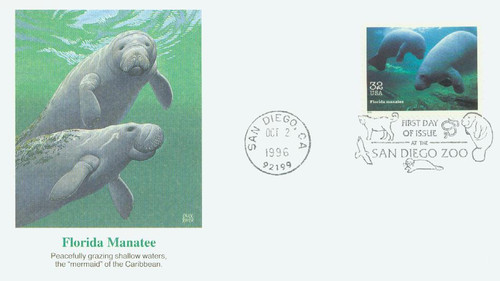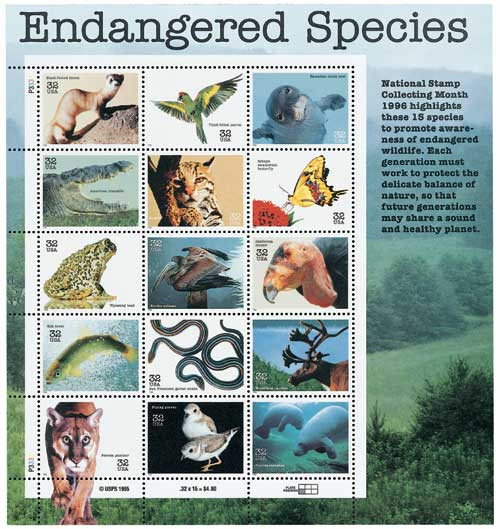
# 3105o - 1996 32c Endangered Species: Florida Manatee
US #3105o
1996 Florida Manatee
- Part of set of 15 stamps picturing Endangered Species
- Issued during National Stamp Collecting Month
Stamp Category: Commemorative
Set: Endangered Species
Value: 32¢First-Class mail rate
First Day of Issue: October 2, 1996
First Day City: San Diego, California
Quantity Issued: 14,910,000
Printed by: Ashton-Potter (USA) Ltd.
Printing Method: Lithographed
Format: Panes of 15 (3 across, 5 down) from printing plates of 90 (9 across, 10 down)
Perforations: 11.1 x 11
Why the stamp was issued: The pane of 15 Endangered Species stamps was issued as part of the US Postal Service’s National Stamp Collecting Month. The theme for 1996 was “Collect and Protect.” The USPS hoped these stamps would appeal to children, who would then become lifelong stamp collectors.
About the stamp design: The stamps show photographs of 15 animal species that live in America and re threatened with extinction. The photos were taken by James Balog. The animals chosen for the stamps are from all major geographic areas of the US.
The stamp designs were revealed in November 1995. Immediately, there was a strong outcry against the Manatee stamp because the image seemed unnatural for that mammal. Balog went to the Lowry Park Zoo in Tampa, Florida, and used his underwater equipment to photograph the image of a pair of manatees that was used for the stamp.
First Day City: The First Day of Issue ceremony took place at the San Diego Zoo. In 1996, the zoo was celebrating its 80th birthday. The country of Mexico issued its own pane of endangered species stamps on the same day and took part in the First Day of Issue ceremony. (The stamps were not a joint issue.) In addition to honored human guests, two sea lions, an Andean condor, and a North American timber wolf were also in attendance at the celebration.
Unusual fact about the Endangered Species stamps: The 1996 National Stamp Collecting Month was co-sponsored by the US Postal Service and the American Zoo and Aquarium Association.
About the Endangered Species Set: The species shown on the pane of Endangered Species stamps are: Black-footed Ferret, Schaus Swallowtail Butterfly, Brown Pelican, San Francisco Garter Snake, Ocelot, Gila Trout, Hawaiian Monk Seal, Thick-billed Parrot, California Condor, Wyoming Toad, Woodland Caribou, Florida manatee, Florida Panther, Piping Plover, and American Crocodile. All of them are listed on the US Fish and Wildlife Service’s List of Endangered and Threatened Wildlife and Plants.
History this stamp represents: What the manatee lacks in looks it makes up for in its endearing personality. An extremely gentle animal, this huge tropical creature doesn’t exhibit a single aggressive behavior. In fact, it has no known natural enemies, which may explain how the manatee managed to survive in the past. Today, it is the only herbivorous aquatic mammal still alive – consuming up to 65 pounds of aquatic plants a day!
Only recently has the manatee population become seriously threatened. Pollution and waterfront development have contributed to habitat destruction, but the biggest threat comes from motorboats. Of the 1200 manatees which inhabit Florida’s coastal waters, about 50 die each year from boat collisions.
Despite tough skin and a thick layer of blubber, manatees are susceptible to cold, making it necessary for them to stay close to the coast where the water temperature remains above 68°F. Here they spend much of their time resting on the surface of the water where they risk being fatally injured by motorboats. Although laws limiting the speed and number of boats in the manatees’ primary habitat have been passed, they are difficult to enforce, especially in Florida where water sports are viewed as essential to the local economy.
US #3105o
1996 Florida Manatee
- Part of set of 15 stamps picturing Endangered Species
- Issued during National Stamp Collecting Month
Stamp Category: Commemorative
Set: Endangered Species
Value: 32¢First-Class mail rate
First Day of Issue: October 2, 1996
First Day City: San Diego, California
Quantity Issued: 14,910,000
Printed by: Ashton-Potter (USA) Ltd.
Printing Method: Lithographed
Format: Panes of 15 (3 across, 5 down) from printing plates of 90 (9 across, 10 down)
Perforations: 11.1 x 11
Why the stamp was issued: The pane of 15 Endangered Species stamps was issued as part of the US Postal Service’s National Stamp Collecting Month. The theme for 1996 was “Collect and Protect.” The USPS hoped these stamps would appeal to children, who would then become lifelong stamp collectors.
About the stamp design: The stamps show photographs of 15 animal species that live in America and re threatened with extinction. The photos were taken by James Balog. The animals chosen for the stamps are from all major geographic areas of the US.
The stamp designs were revealed in November 1995. Immediately, there was a strong outcry against the Manatee stamp because the image seemed unnatural for that mammal. Balog went to the Lowry Park Zoo in Tampa, Florida, and used his underwater equipment to photograph the image of a pair of manatees that was used for the stamp.
First Day City: The First Day of Issue ceremony took place at the San Diego Zoo. In 1996, the zoo was celebrating its 80th birthday. The country of Mexico issued its own pane of endangered species stamps on the same day and took part in the First Day of Issue ceremony. (The stamps were not a joint issue.) In addition to honored human guests, two sea lions, an Andean condor, and a North American timber wolf were also in attendance at the celebration.
Unusual fact about the Endangered Species stamps: The 1996 National Stamp Collecting Month was co-sponsored by the US Postal Service and the American Zoo and Aquarium Association.
About the Endangered Species Set: The species shown on the pane of Endangered Species stamps are: Black-footed Ferret, Schaus Swallowtail Butterfly, Brown Pelican, San Francisco Garter Snake, Ocelot, Gila Trout, Hawaiian Monk Seal, Thick-billed Parrot, California Condor, Wyoming Toad, Woodland Caribou, Florida manatee, Florida Panther, Piping Plover, and American Crocodile. All of them are listed on the US Fish and Wildlife Service’s List of Endangered and Threatened Wildlife and Plants.
History this stamp represents: What the manatee lacks in looks it makes up for in its endearing personality. An extremely gentle animal, this huge tropical creature doesn’t exhibit a single aggressive behavior. In fact, it has no known natural enemies, which may explain how the manatee managed to survive in the past. Today, it is the only herbivorous aquatic mammal still alive – consuming up to 65 pounds of aquatic plants a day!
Only recently has the manatee population become seriously threatened. Pollution and waterfront development have contributed to habitat destruction, but the biggest threat comes from motorboats. Of the 1200 manatees which inhabit Florida’s coastal waters, about 50 die each year from boat collisions.
Despite tough skin and a thick layer of blubber, manatees are susceptible to cold, making it necessary for them to stay close to the coast where the water temperature remains above 68°F. Here they spend much of their time resting on the surface of the water where they risk being fatally injured by motorboats. Although laws limiting the speed and number of boats in the manatees’ primary habitat have been passed, they are difficult to enforce, especially in Florida where water sports are viewed as essential to the local economy.










